Effects of Water Content and Temperature on Bulk Resistivity of Hybrid Cement/Carbon Nanofiber Composites
Abstract
:1. Introduction
2. Materials and Methods
2.1. Preparation of Cement–CNF Materials and Resistivity Measurements
- R is the electrical resistance measured between connectors,
- A is the surface area of a connector,
- l is the distance between connectors.
2.2. X-Ray Micro-Computed Tomography (µ-CT)
2.3. Scanning Electron Microscopy (SEM)
2.4. Powder X-Ray Diffraction (XRD)
3. Results and Discussion
3.1. Significance of Electrical Connection Type for Bulk Resistivity of Cement–CNF Transducers at Higher Temperatures
3.2. Effect of w/c Ratio and Pore Water Content on Bulk Resistivity of Cement–CNF Materials
4. Conclusions
- (1)
- The electrical response of these materials is related with two types of water present in the cement: (a) water that is mixed with cement powder and is partially consumed in cement hydration processes, and (b) free water that is present in cement pores that can be removed by drying.
- (2)
- The increase in the water to cement ratio at the stage of cement mixing results in increased bulk resistivity. This has been attributed to the precipitation of larger amounts of hydration products that leads to a larger separation of carbon nanofibers and, thus larger resistivity.
- (3)
- The material response to a stepwise temperature increase up to 180 °C is related to free water release from cement pores and the dry materials are relatively insensitive to temperature changes. The re-saturation of pores with water results in a slightly increased resistivity but the re-saturation process is not entirely reversible.
- (4)
- The choice of electrical connector material, form, and size are important factors that have to be considered when designing high temperature sensors based on conductive cements. A very important design parameter that must also be taken into account is the effective contact surface area of the electrical connector material with the cement–CNF matrix. It has been shown that the change in the type of electrical connection can lead to two orders of magnitude different bulk resistivity results for the same material.
Supplementary Materials
Author Contributions
Funding
Acknowledgments
Conflicts of Interest
References
- Golewski, G.L. Energy Savings Associated with the Use of Fly Ash and Nanoadditives in the Cement Composition. Energies 2020, 13, 2184. [Google Scholar] [CrossRef]
- Ahmed, H.; Bogas, J.A.; Guedes, M. Mechanical Behavior and Transport Properties of Cementitious Composites Reinforced with Carbon Nanotubes. J. Mater. Civil Eng. 2018, 30, 04018257. [Google Scholar] [CrossRef]
- Hawreen, A.; Bogas, J.A. Creep, shrinkage and mechanical properties of concrete reinforced with different types of carbon nanotubes. Constr. Build. Mater. 2019, 198, 70–81. [Google Scholar] [CrossRef]
- Hawreen, A.; Bogas, J.A.; Kurda, R. Mechanical Characterization of Concrete Reinforced with Different Types of Carbon Nanotubes. Arab. J. Sci. Eng. 2019, 44, 8361–8376. [Google Scholar] [CrossRef]
- Buasiri, T.; Habermehl-Cwirzen, K.; Krzeminski, L.; Cwirzen, A. Piezoresistive load sensing and percolation phenomena in portland cement composite modified with in-situ synthesized carbon nanofibers. Nanomaterials 2019, 9. [Google Scholar] [CrossRef] [Green Version]
- Zhou, Z.; Xie, N.; Cheng, X.; Feng, L.; Hou, P.; Huang, S.; Zhou, Z. Electrical properties of low dosage carbon nanofiber/cement composite: Percolation behavior and polarization effect. Cem. Concr. Compos. 2020, 109. [Google Scholar] [CrossRef]
- Chung, D. Electrically Conductive Cement-Based Materials. Adv. Cem. Res. 2004, 16, 167–176. [Google Scholar] [CrossRef]
- Meoni, A.; D’Alessandro, A.; Downey, A.; García-Macías, E.; Rallini, M.; Materazzi, A.L.; Torre, L.; Laflamme, S.; Castro-Triguero, R.; Ubertini, F. An Experimental Study on Static and Dynamic Strain Sensitivity of Embeddable Smart Concrete Sensors Doped with Carbon Nanotubes for SHM of Large Structures. Sensors (Basel, Switzerland) 2018, 18, 831. [Google Scholar] [CrossRef] [Green Version]
- Carmona, F.; Canet, R.; Delhaes, P. Piezoresistivity of heterogeneous solids. J. Appl. Phys. 1987, 61, 2550–2557. [Google Scholar] [CrossRef]
- Wang, X.; Fu, X.; Chung, D.D.L. Strain sensing using carbon fiber. J. Mater. Res. 1999, 14, 790–802. [Google Scholar] [CrossRef]
- Sun, M.; Liu, Q.; Li, Z.; Hu, Y. Study of piezoelectric properties of carbon fiber reinforced concrete and plain cement paste during dynamic loading. Cem. Concr. Res. 2000, 30, 1593–1595. [Google Scholar] [CrossRef]
- Newnham, R.E.; Bowen, L.J.; Klicker, K.A.; Cross, L.E. Composite piezoelectric transducers. Mater. Des. 1980, 2, 93–106. [Google Scholar] [CrossRef]
- Li, Z.; Zhang, D.; Wu, K. Cement-based 0-3 piezoelectric composites. J. Am. Ceram. Soc. 2002, 85, 305–313. [Google Scholar] [CrossRef]
- Han, B.; Ou, J. Embedded piezoresistive cement-based stress/strain sensor. Sens. Actuators A Phys. 2007, 138, 294–298. [Google Scholar] [CrossRef]
- Dietrich Stauffer, A.A. Introduction to Percolation Theory; Taylor & Francis: London, UK, 1994. [Google Scholar]
- Czyzewski, J.B.P.; Gaweł, K.; Meisner, J. Rapid prototyping of electrically conductive components using 3D printing technology. J. Mater. Process. Technol. 2009, 209, 5281–5285. [Google Scholar] [CrossRef]
- Ramam, K.; Chandramouli, K. Piezoelectric cement composite for structural health monitoring. Adv. Cem. Res. 2012, 24, 165–171. [Google Scholar] [CrossRef]
- Monteiro, A.O.; Loredo, A.; Costa, P.M.F.J.; Oeser, M.; Cachim, P.B. A pressure-sensitive carbon black cement composite for traffic monitoring. Constr. Build. Mater. 2017, 154, 1079–1086. [Google Scholar] [CrossRef]
- Zhang, J.; Lu, Y.; Lu, Z.; Liu, C.; Sun, G.; Li, Z. A new smart traffic monitoring method using embedded cement-based piezoelectric sensors. Smart Mater. Struct. 2015, 24. [Google Scholar] [CrossRef]
- Wen, S.; Chung, D.D.L. Piezoelectric cement-based materials with large coupling and voltage coefficients. Cem. Concr. Res. 2002, 32, 335–339. [Google Scholar] [CrossRef]
- Saafi, M. Wireless and embedded carbon nanotube networks for damage detection in concrete structures. Nanotechnology 2009, 20, 395502. [Google Scholar] [CrossRef]
- Downey, A.; D’Alessandro, A.; Baquera, M.; García-Macías, E.; Rolfes, D.; Ubertini, F.; Laflamme, S.; Castro-Triguero, R. Damage detection, localization and quantification in conductive smart concrete structures using a resistor mesh model. Eng. Struct. 2017, 148, 924–935. [Google Scholar] [CrossRef] [Green Version]
- Baeza, F.J.; Galao, O.; Zornoza, E.; Garcés, P. Multifunctional Cement Composites Strain and Damage Sensors Applied on Reinforced Concrete (RC) Structural Elements. Materials 2013, 6, 841–855. [Google Scholar] [CrossRef] [PubMed] [Green Version]
- Wen, S.; Chung, D.D.L. Model of piezoresistivity in carbon fiber cement. Cem. Concr. Res. 2006, 36, 1879–1885. [Google Scholar] [CrossRef]
- Yang, N.; Zhang, K.; Sun, Q. Dispersion and Pressure Sensitivity of Carbon Nanofiber-Reinforced Polyurethane Cement. Appl. Sci. 2018, 8, 2375. [Google Scholar] [CrossRef] [Green Version]
- Zhang, L.; Ding, S.; Han, B.; Yu, X.; Ni, Y.-Q. Effect of water content on the piezoresistive property of smart cement-based materials with carbon nanotube/nanocarbon black composite filler. Compos. Part A Appl. Sci. Manuf. 2019, 119, 8–20. [Google Scholar] [CrossRef]
- Wang, H.; Shen, J.; Liu, J.; Lu, S.; He, G. Influence of carbon nanofiber content and sodium chloride solution on the stability of resistance and the following self-sensing performance of carbon nanofiber cement paste. Case Stud. Constr. Mater. 2019, 11, e00247. [Google Scholar] [CrossRef]
- Wang Baomin, F.C. Comparative Study on Dispersion of Carbon Nanofibers and Enhancement on Mechanical Property and Microstructure in Cement Composites. J. Nanosci. Nanotechnol. 2020, 20, 113–120. [Google Scholar] [CrossRef]
- Yazdani, N.; Brown, E. 3-Carbon nanofibers in cement composites: Mechanical reinforcement. In Innovative Developments of Advanced Multifunctional Nanocomposites in Civil and Structural Engineering; Loh, K.J., Nagarajaiah, S., Eds.; Woodhead Publishing: Oxford, UK, 2016; pp. 47–58. [Google Scholar]
- Luo, J.; Duan, Z.; Li, H. The influence of surfactants on the processing of multi-walled carbon nanotubes in reinforced cement matrix composites. Phys. Status Solidi (a) 2009, 206, 2783–2790. [Google Scholar] [CrossRef]
- Rosół, K.; Szczubiałka, K.; Jachimska, B.; Zapotoczny, S.; Nowakowska, M. Interactions of a smart cationic polyelectrolyte based on hydroxypropylcellulose with an anionic surfactant. J. Appl. Polym. Sci. 2008, 107, 3184–3189. [Google Scholar] [CrossRef]
- Yazdanbaksh, A.; Grasley, Z.; Tyson, B.; Abu Al-Rub, R. Carbon Nanofibers and Nanotubes in Cementitious Materials: Some Issues on Dispersion and Interfacial Bond. ACI SP 2009, 267, 21–34. [Google Scholar]
- Silva, B.A.; Ferreira Pinto, A.P.; Gomes, A.; Candeias, A. Suitability of different surfactants as air-entraining admixtures for lime mortars. Constr. Build. Mater. 2020, 256, 118986. [Google Scholar] [CrossRef]
- Djouani, F.; Connan, C.; Delamar, M.; Chehimi, M.M.; Benzarti, K. Cement paste–epoxy adhesive interactions. Constr. Build. Mater. 2011, 25, 411–423. [Google Scholar] [CrossRef]
- Chavez Panduro, E.A.; Torsæter, M.; Gawel, K.; Bjørge, R.; Gibaud, A.; Bonnin, A.; Schlepütz, C.M.; Breiby, D.W. Computed X-ray Tomography Study of Carbonate Precipitation in Large Portland Cement Pores. Cryst. Growth Des. 2019, 19, 5850–5857. [Google Scholar] [CrossRef]
- Tzounis, L.; Liebscher, M.; Fuge, R.; Leonhardt, A.; Mechtcherine, V. P- and n-type thermoelectric cement composites with CVD grown p- and n-doped carbon nanotubes: Demonstration of a structural thermoelectric generator. Energy Build. 2019, 191, 151–163. [Google Scholar] [CrossRef]
- Wen, S.; Chung, D.D.L. The role of electronic and ionic conduction in the electrical conductivity of carbon fiber reinforced cement. Carbon 2006, 44, 2130–2138. [Google Scholar] [CrossRef]
- Wandelt, K. Encyclopedia of Interfacial Chemistry: Surface Science and Electrochemistry, 1st ed.; Elsevier: Amsterdam, the Netherlands, 2018; p. 712. [Google Scholar]
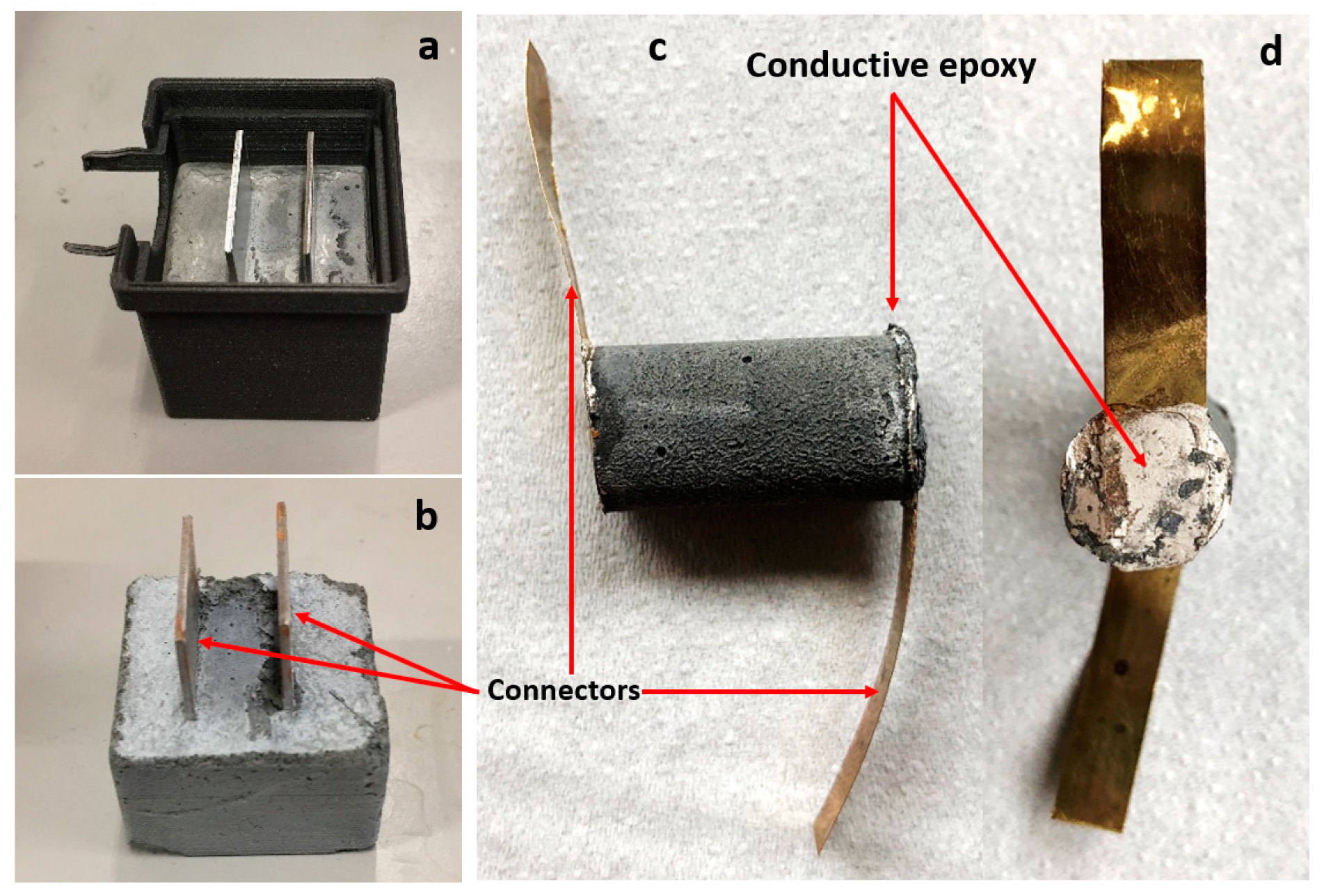
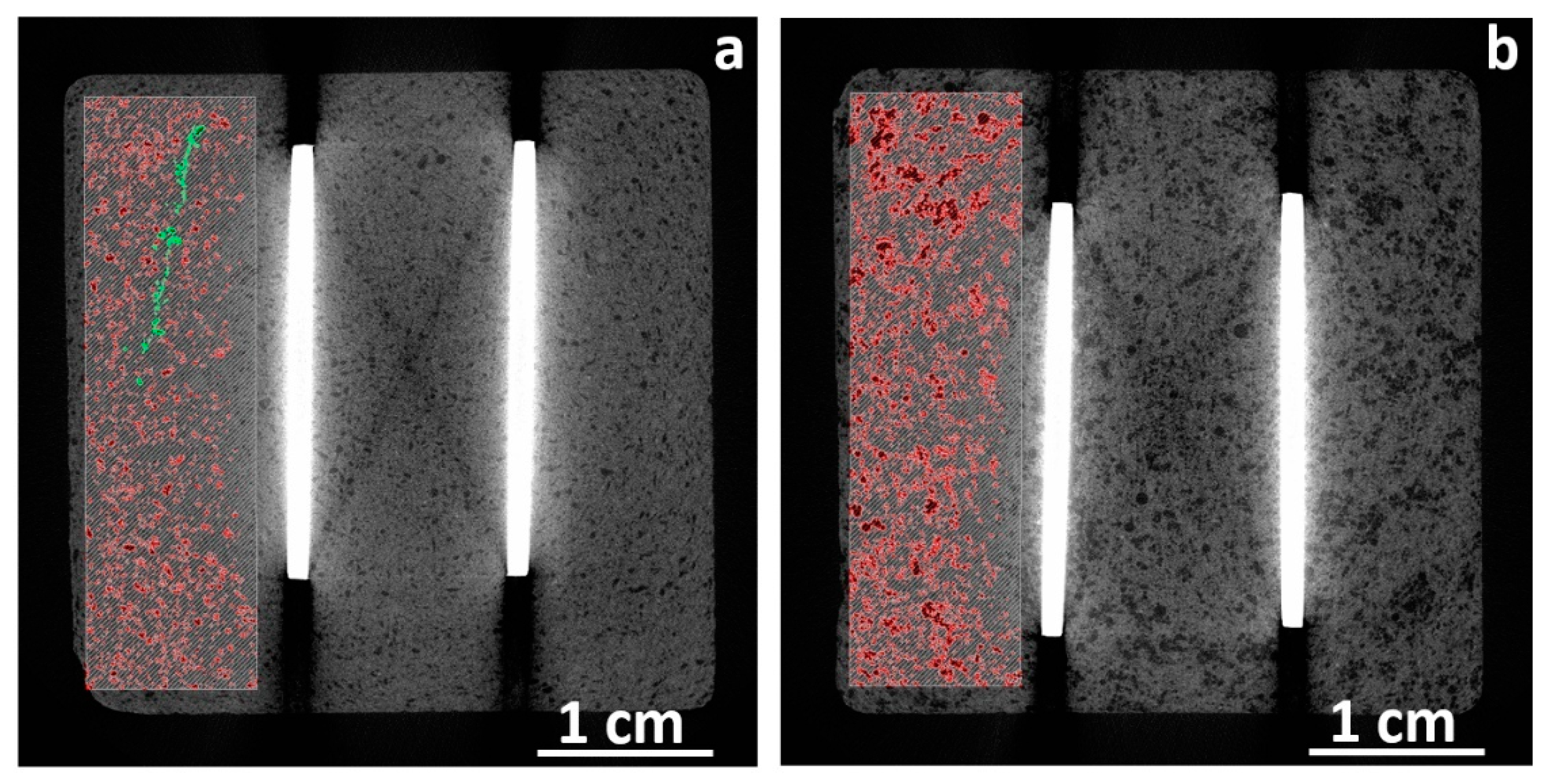
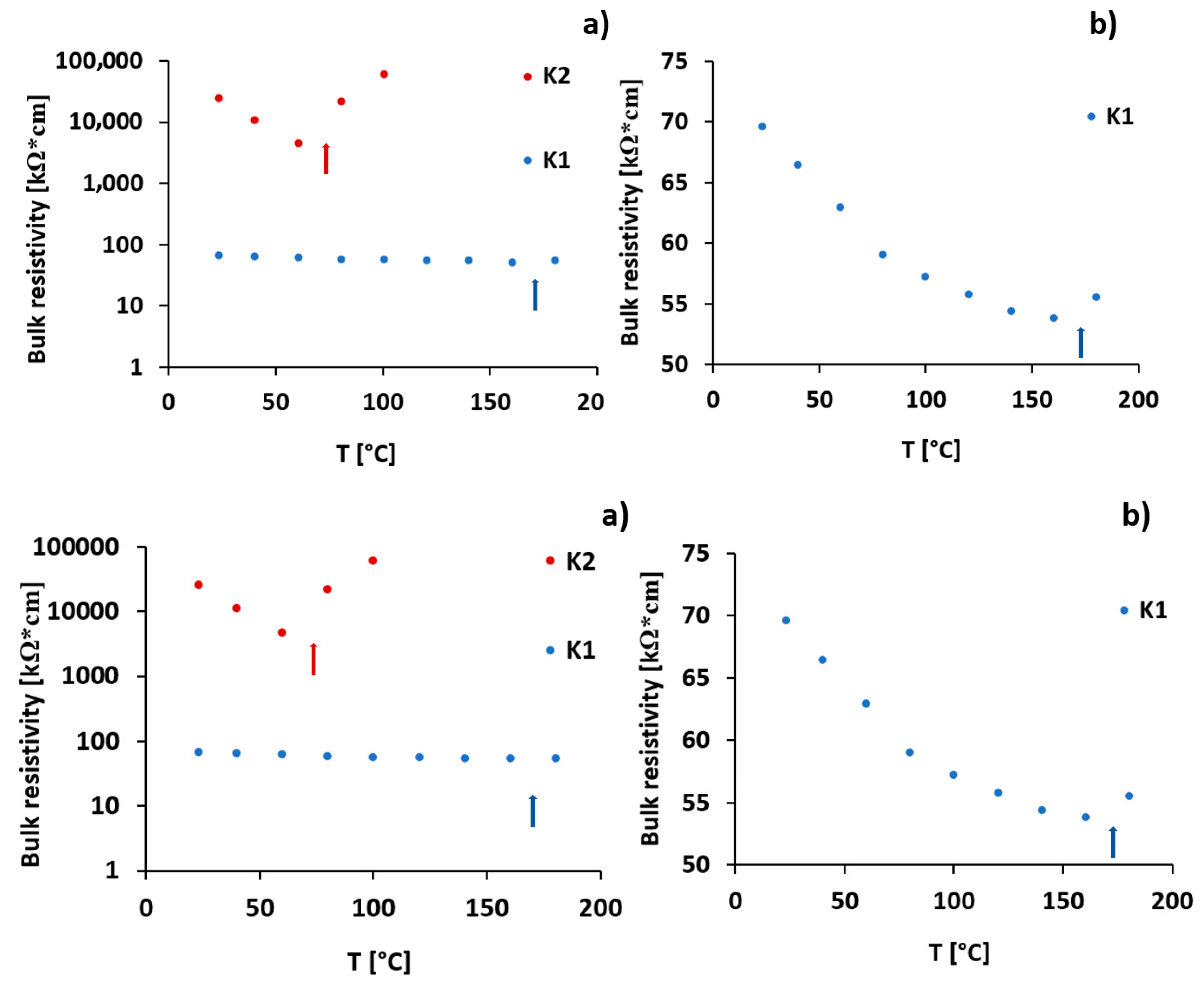
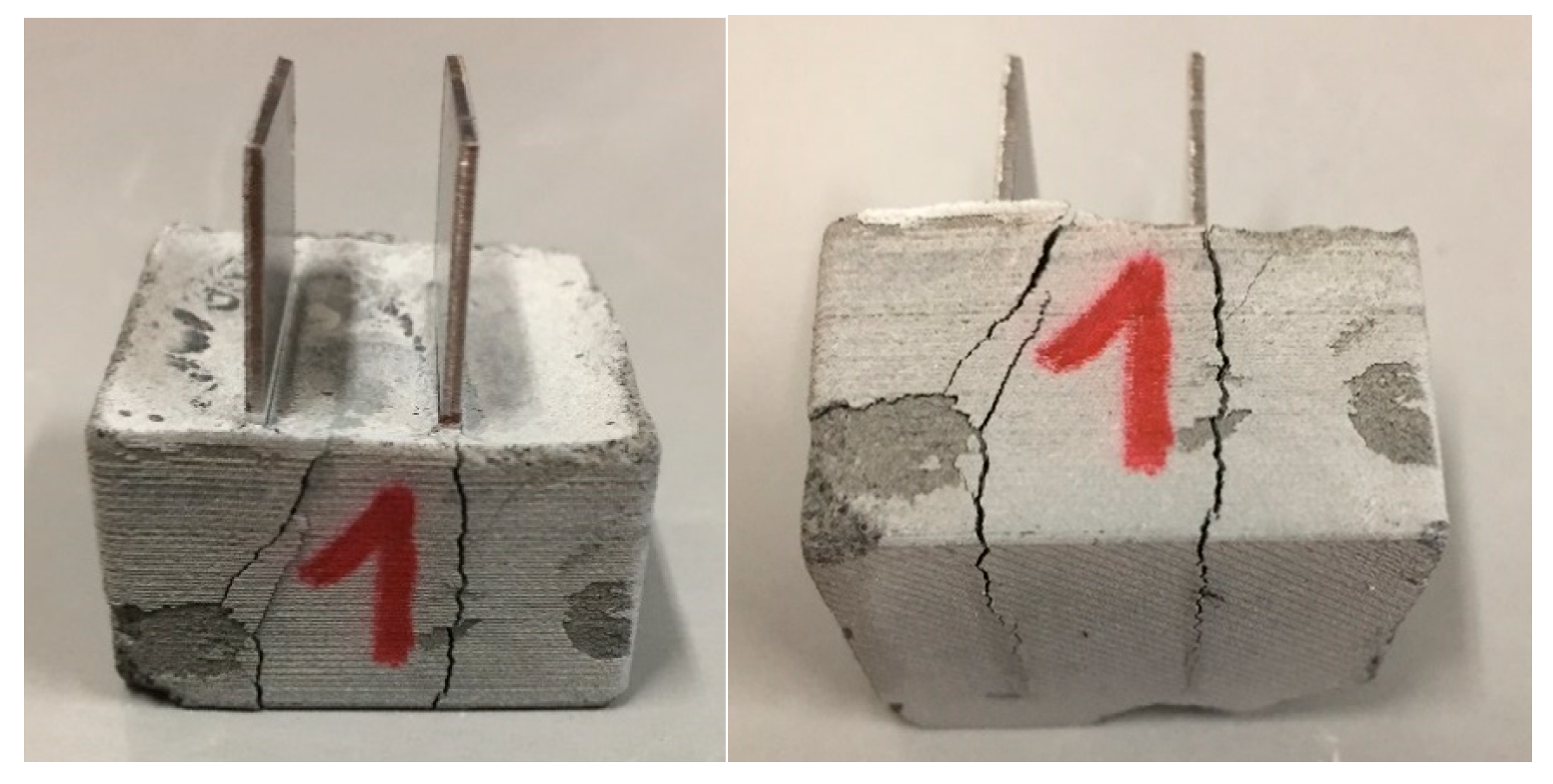
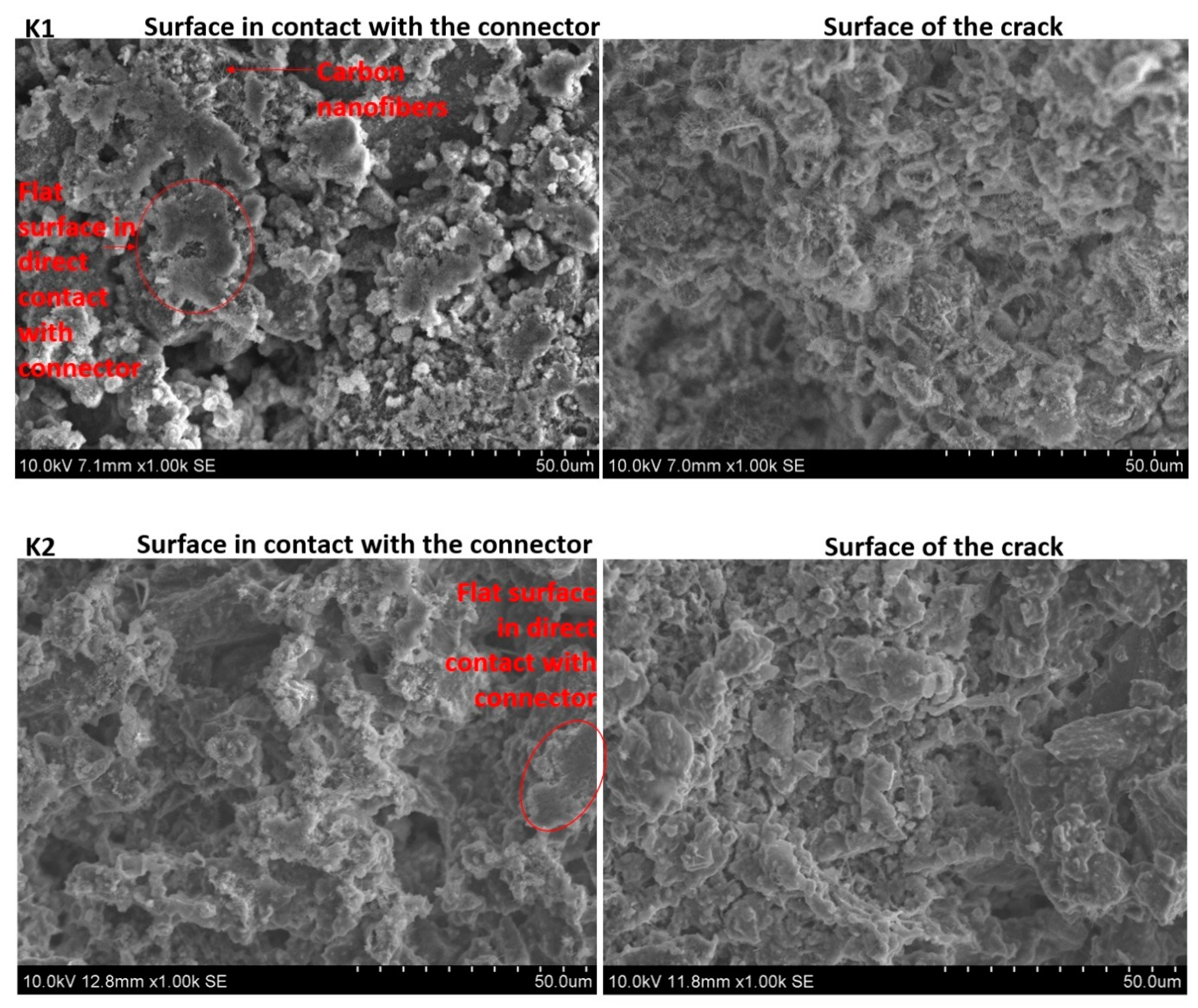
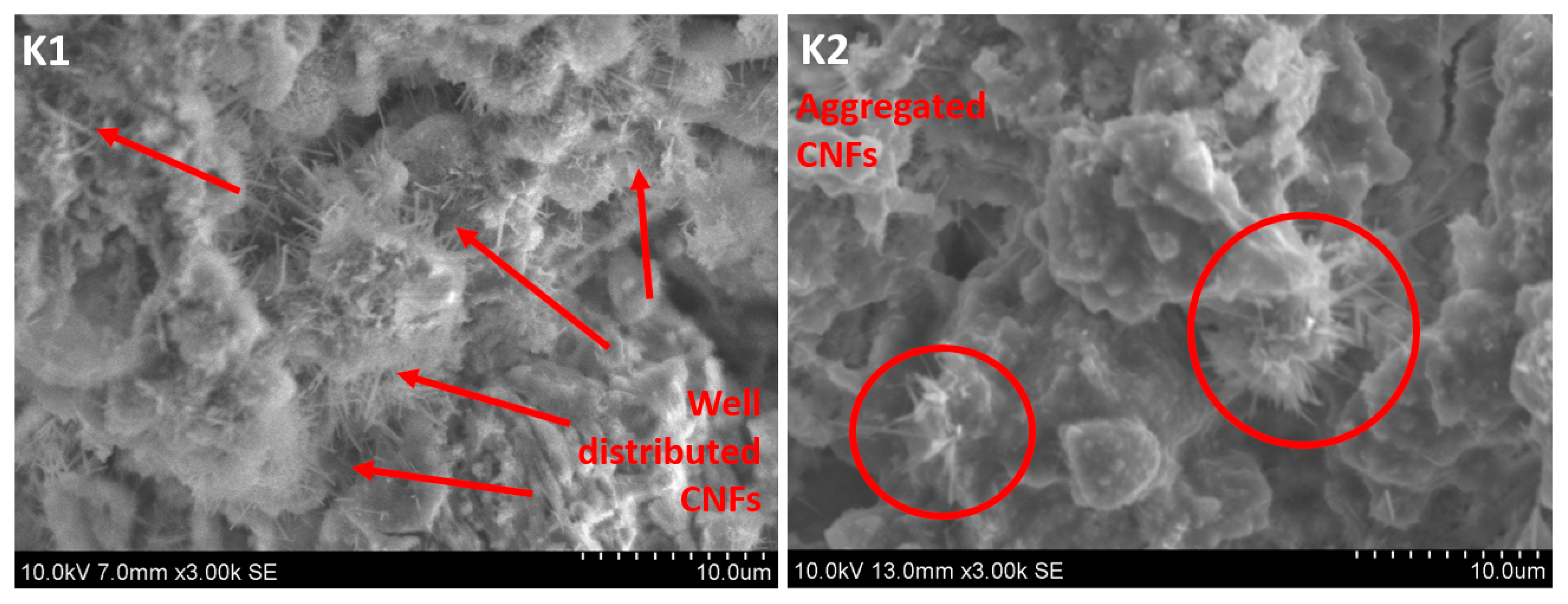
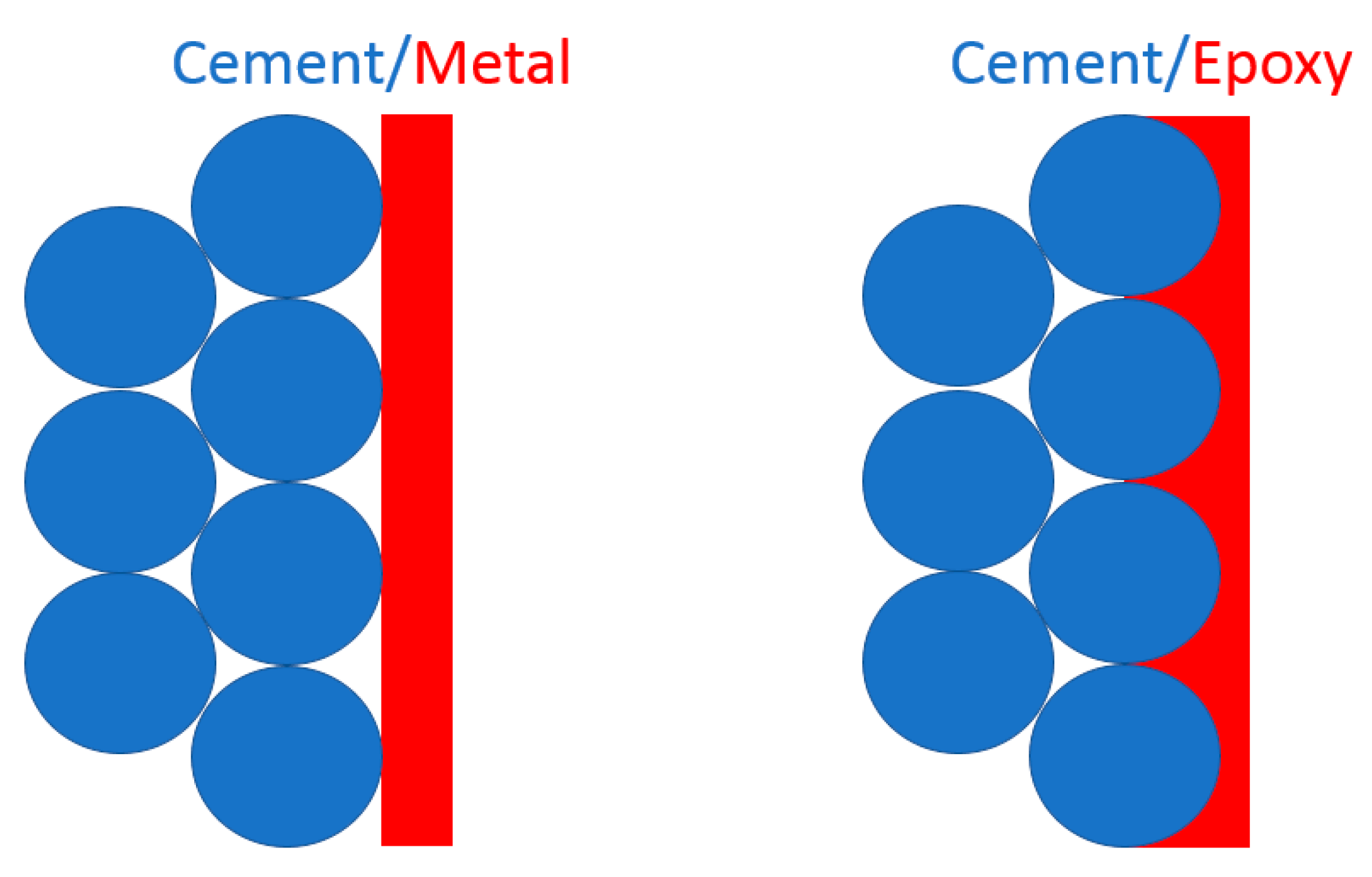
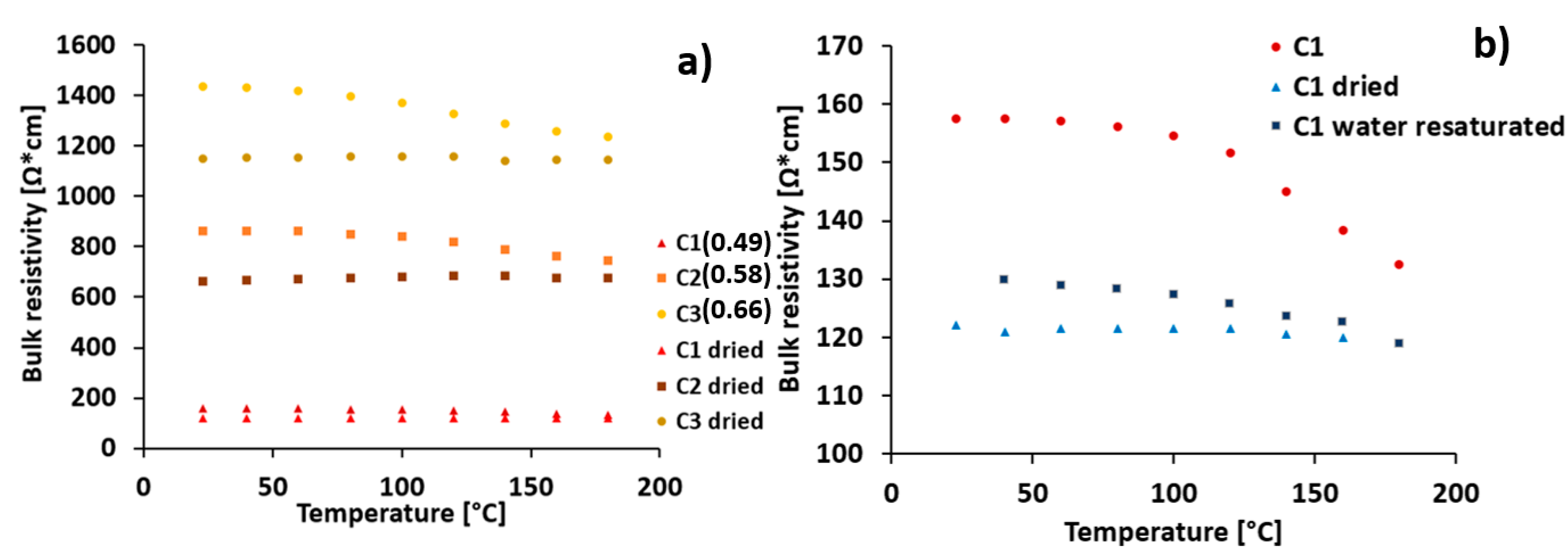


| Sample Name | Form | Dispersant | CNF/Cement | Water/Cement | Dispersant/Cement |
|---|---|---|---|---|---|
| K1 | cube | SP | 0.03 | 0.58 | 0.012 |
| K2 | cube | SP + SDS | 0.03 | 0.58 | 0.012 |
| C1 | cylinder | SP | 0.03 | 0.49 | 0.012 |
| C2 | cylinder | SP | 0.03 | 0.58 | 0.012 |
| C3 | cylinder | SP | 0.03 | 0.66 | 0.012 |
| C1 | C2 | C3 | |
|---|---|---|---|
| Corundum | 100.0 | 100.0 | 100.0 |
| CH | 8.1 | 9.3 | 10.0 |
| C4AF | 3.5 | 3.0 | 2.8 |
| C3S | 7.0 | 4.2 | 3.7 |
© 2020 by the authors. Licensee MDPI, Basel, Switzerland. This article is an open access article distributed under the terms and conditions of the Creative Commons Attribution (CC BY) license (http://creativecommons.org/licenses/by/4.0/).
Share and Cite
Gawel, K.; Taghipour Khadrbeik, M.A.; Bjørge, R.; Wenner, S.; Gawel, B.; Ghaderi, A.; Cerasi, P. Effects of Water Content and Temperature on Bulk Resistivity of Hybrid Cement/Carbon Nanofiber Composites. Materials 2020, 13, 2884. https://doi.org/10.3390/ma13132884
Gawel K, Taghipour Khadrbeik MA, Bjørge R, Wenner S, Gawel B, Ghaderi A, Cerasi P. Effects of Water Content and Temperature on Bulk Resistivity of Hybrid Cement/Carbon Nanofiber Composites. Materials. 2020; 13(13):2884. https://doi.org/10.3390/ma13132884
Chicago/Turabian StyleGawel, Kamila, Mohammad Ali Taghipour Khadrbeik, Ruben Bjørge, Sigurd Wenner, Bartlomiej Gawel, Amir Ghaderi, and Pierre Cerasi. 2020. "Effects of Water Content and Temperature on Bulk Resistivity of Hybrid Cement/Carbon Nanofiber Composites" Materials 13, no. 13: 2884. https://doi.org/10.3390/ma13132884
APA StyleGawel, K., Taghipour Khadrbeik, M. A., Bjørge, R., Wenner, S., Gawel, B., Ghaderi, A., & Cerasi, P. (2020). Effects of Water Content and Temperature on Bulk Resistivity of Hybrid Cement/Carbon Nanofiber Composites. Materials, 13(13), 2884. https://doi.org/10.3390/ma13132884





